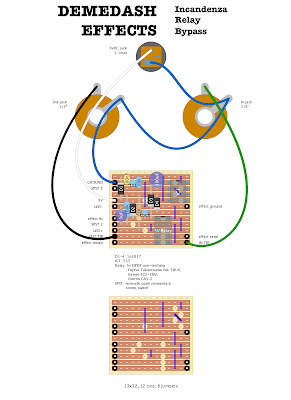Here is a contribution from Chris Stelloh that seem to be really useful.
Chris says:
This is an updated version of the Demedash Incandenza micro-controller
free clickless relay true bypass switch. It takes up a bit more room
than a simple 3pdt, but because of the friction-free operation of the
SPST button, it will last WAY longer than that same traditional,
mechanical 3pdt switch. I realize that most folks will not want to build
an extra board where just a footswitch will do... but for those of us
that DO, here's my drawing of a super-slick, silent, clickless relay
that doesn't require any coding or microcontrollers. There are a few
earlier versions of this circuit floating around the web, but this one
has a very important update from Steve Demedash himself. The power
filtering and 100 ohm resistor between the 555 and the relay is super
important. I found that the power spike when engaging the flip flop was
enough to mess with other circuitry that was close to the switch. For
example: I had a dual circuit build with independent on/off switches and
triggering one would sometimes trigger the other one unintentionally.
Anyway - here's a boring utility layout that has ended up being the
thing I build the most, since I put these in just about any circuit that
will permit it. This layout also allows you to omit the polarity
protection diode for the main board and the status LED as well since
those are both contained here on this switch daughterboard. The 5v DPDT
relays you can use for this are not limited to just these three -
however, these three are the smallest and most inexpensive I've found so
far. Also - I don't like to use standing axial components or 3-row
resistors but in the case of this board, I wanted to keep it as small as
possible. Be sure and notice the anode of D3 connected to ground!

I couldn't understand why so many manufacturers had "switched" to using relays until recently I read that they can be more reliable. I will say that my Empress Delay needs to be blown out with cleaner on the reg. The momentary switches can be prone to malfunction, I find. But this is a nice option to save in the files. I have actually been having an issue with mechanical switches failing on me lately. I'd love a suggestion for a quality 3PDT supplier or brand that isn't too unreasonable. Chris or anybody with an opinion...
ReplyDeleteHey Tom - for the builds I do that require a 3pdt instead of one of these relay switches, I've had good luck with Alpha switches (I use the ones that have the stiffest throw) and the (more expensive) Gorva 3pdt stomps that have the softer click. As far as momentary/SPST stomp switches, I spend out on the expensive ones since they usually aren't much more and feel really solid. When it comes to relay switching, often times, the failure doesn't really have anything to do with mechanical stuff - mistriggering is usually the result of bad circuit design or dodgy quality control on the parts. I actually went through a bunch of different circuits trying to find one that didn't pop or mistrigger and this one hasn't failed me yet!
DeleteIt's a good option yeah but I generally prefer the dumbest solutions. So clunky big switches good. Little soft switches... bad. I tended to buy the cheap stuff in the past and as a result, all of my switches are dying on me. Living in a soggy garden unit doesn't help.
DeleteI will try the above when I get the relay. I also like an optical bypass that I found and I think posted on the Barbershop V1 layout. It works a treat. DPDT switches also are apparently more robustly made. They feel better.
I recently made a pedal with 'Soft touch' using a PCB from Parasit Studio, and it was well worth the effort. I may give this one a try, cheers Chris!!
ReplyDeleteI went through a lot of trial and error w DIY relay switches before I settled on this one. For what it is worth - the kemet EC2-5NU relay is the one that the designer recommends - and it also happens to be dirt cheap (like $1-$2 depending on where and how many you buy). And it's bright orange, which of course doesn't matter but is still a bonus in my book. Good luck, Ian!
DeleteThis looks like a great little circuit to play around with on breadboard. Is there a schematic for it?
ReplyDeleteThere's quite a few, actually! The one I used was from the DIY building blog section of demedash effects' website. https://www.demedasheffects.com/blog/vlknkvj643gnuiggvr34ir1r75b72m
Delete